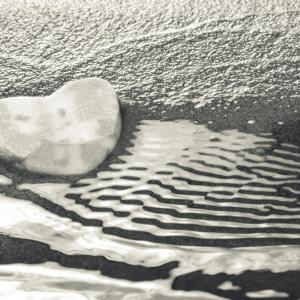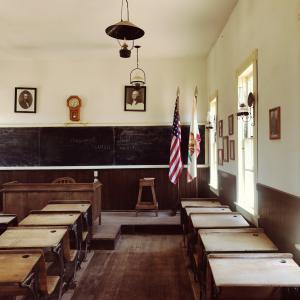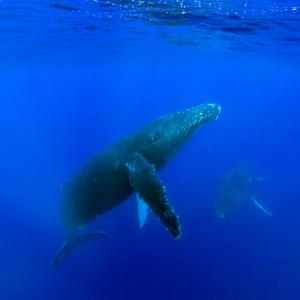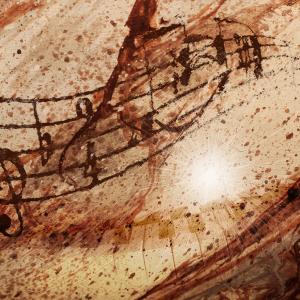Trevor Scott Barton is an elementary school teacher in Greenville, S.C. He is a blogger for the Teaching Tolerance project of the Southern Poverty Law Center.
Posts By This Author
God Is Allowed in School
Whether I am on an inner-city street, or a remote village, or in a Title I public school classroom, I try to live out my life as Gustavo Gutiérrez describes life among the poor in his book A Theology of Liberation.
Other People's Shoes
I have been thinking about what it means for me to try to put myself into the shoes of other people, too. When I see someone who is different from me — a transgender person, a Muslim person, a politically conservative person, an 'any kind of different' person — I am tempted to look at that person through a hermeneutic of fear. I either fight against that person or flee from that person. But what if I look at that person through a hermeneutic of empathy? What if I put myself in that person's shoes and walk around? What might happen if I do that?
Listen to Their Faces
Listening to faces is hard work and has to be developed slowly over time. We live in a world that teaches us to speak twice as much as we listen, or to speak without listening at all. Yet, over time, listening to faces will grow the most important thing we can have in our hearts — deep empathy for each person we encounter every day.
The Shape of God's Heart

Wolkenengel565 / Shutterstock.com
Father Gregory Boyle is a Jesuit priest and the founder of Homeboy Industries in East Los Angeles. He lives and works in his economically poor and gang-riddled community building kinship, making close relationships and connections, with the people around him. He affectionately calls his parishioners "homies" and they affectionately call him "G-Dog." I highly recommend his book Tattoos on the Heart: The Power of Boundless Compassion if you, too, are interested in building kinship in the world.
In the book Father Greg tells the story of taking two homies to the White House as a part of then First Lady Laura Bush's Helping America's Youth campaign. On the flight back to L.A., one of the homies talks to a flight attendant and tells her about his life, about what his life had been, about going to the White House, and about what his life was becoming. His story made the flight attendant cry, he tells to Father Greg. And Father Greg says to him, "Well, mijo, whaddya 'spect? She just caught a glimpse of ya. She saw that you are somebody. She recognized you as the shape of God's heart. Sometimes people cry when they see that."
Thoughts by the Sea
One question I would ask a blue whale, if I could summon it from the depths of the ocean, would be, "Is it your giant heart that makes your kind the most peaceful and intelligent creatures on Earth?"
I often wonder about the link between the heart and kindness and intelligence. "Cogit ergo sum (I think therefore I am)," wrote René Descartes, and we live in a time where the sum of all of life is the mind, the value of all of life is the ability to be right and to be smarter than anyone else.
But what of "sentimus ergo sumus (we feel therefore we are)?” Is the sum of all of life really empathy, the practice of placing ourselves in the shoes of fellow human beings and walking around in those shoes until we can feel life as they feel it?
"If we value the growth of our hearts most of all, could we be more like you?," I would ask my giant, gentle friend.
Shadows
In my classroom, there is a little boy from Honduras. He speaks Spanish — that is the language of his heart — but he is learning English and tries with all his heart to learn new words and strange phrases that will allow him to live in his new world here. He is 9 years old, with dark hair cut straight across his forehead in a wonderfully crooked line. He has deep brown eyes the color of a plowed field, eyes that sparkle like starlight at night off a pool of calm water. He has big dimples that catch teardrops when he laughs until he cries, or when he cries until the sadness in his heart resides. He has a broad smile that is sometimes mischievous but most times full of joy.
Sometimes I wonder ... what is he thinking as he closes his eyes at the end of the day, or opens them at dawn?
"I hope my new world will embrace me," he thinks tenderly, "and not call me an illegal alien ... and not try to tear me apart from my Aunt ... and not try to tear me apart ... and not place me in the shadows ... and not make me a shadow.
Mami, can you hear me in the dawn? Will my words reach you over the land, over the land, to the valley, between the mountains, to La Esperanza, to Honduras? Help me, Mami. Please. I don't want to be a shadow here. ...
Lessons from the World's Loneliest Whale
In the northern Pacific Ocean, there is a giant whale named 52 Hertz. Scientists named him that because when he sings, the frequency of his whale song is around 52 Hertz. When other whales sing their songs, they sing at frequencies between 15 and 25 Hertz. His song cannot be heard by any other whale. He is known as the loneliest whale in the world.
Normally whales are communal creatures. They live their lives in family groups. They migrate from warm waters to cooler waters to give birth and find food. They follow the same migration route from year to year. 52 Hertz is different. He lives alone. He does not follow a migration route. He wanders the ocean, a lonely, wandering whale.
We do not know what kind of whale 52 Hertz is. He could be a deformed blue or fin whale. He could be a cross breed of those two types of whales. He could be a kind of whale we have yet to discover. He is an unknown whale.
Soon a team will set out on a seven-week expedition in search of 52 Hertz. Will they find him? Will he find them? Does he want to be found? I wonder.
From the Dust of the Ground
The ground on our mountain is rocky ground and the land seems to have more stones on it than soil. I think it is a miracle that things grow here, that things grow so well here. But they do. We are planting, as all farmers do, in the hope that good rains will come and help the seeds grow into whole, full stalks of millet. I am enjoying learning the life of a Malinke farmer. Bala is my teacher. This is his field.
Seeing The Human Spirit
There is a small, mud-bricked, tin-roofed building on a piece of flat land below a mountain in Kenieba, Mali. This simple structure, surrounded by courtyards, peanut fields, and scrub grass, is the church building where we lived for three years, a place that became our home. The people who are this church are simple people like the building itself. Most of them are subsistence farmers growing just enough peanuts, millet, rice and corn to eat for the year. When I think of these friends of ours, three people come to mind who symbolize them all.
The Space Between the Notes
The French composer Claude Debussy once said, "Music is the space between the notes." His compositions were a part of Impressionism in music, a movement in the late 19th and early 20th centuries that focused on suggestion and atmosphere and favored short forms of music like nocturnes, arabesques, and preludes. This movement was a correction of the excesses of the Romantic period, where the focus was on strong emotion and the depiction of stories and the favor was toward long forms of music like symphonies and concertos.
A Whale of a Lesson
I created my SOLE space by providing one desktop computer per four students, a whiteboard to write questions on, and paper and pens for students to take notes for their sharing at the end of SOLE.
Then I asked a big question — “Why does a blue whale have such an enormous heart?” — and I let the adventure begin. My students began their investigations.
After 40 minutes, they shared their discoveries.
“Blue whales swim all over the world,” said Ki’ara, “So they need a gargantuan heart to be their motor.”
“Blue whales can call to each other over almost a thousand miles,” said Heavenly. “They need a big heart to talk to each other.”
“They swim together in pairs,” said Amare, “So they need huge hearts to care for each other.”
“Yeah,” said Isaac, “That’s true … it takes a huge heart to care for somebody.”
“Kids who are nice to me on the playground must have a big heart like a blue whale,” added Aydan. “And people who are mean must have small hearts.”
“Hmmm,” I said. “How can we have big hearts for each other instead of small hearts?”
Our Stories To Tell
"We all have a story to tell."
These are the words that will greet my new elementary students as they enter my classroom this year.
I will tell them my story: who I am, what I do, when I was born, where I have lived, why I am a teacher, how I came to our school.
I will tell them this story: When I was their age, I carried a tattered journal, a Papermate pen, and a pocket dictionary everywhere I went. I wrote about the people, places, and things I saw with my eyes, heard with my ears, smelled with my nose, tasted with my tongue, and felt with my hands. I put down on paper the ideas and feelings that were floating around in my head and my heart. I was nerdy (and still am) ... but I was me!
"Will you tell me your story?" I will ask them.
Farmer
Grandpa, you are my Pepa. Before me, you were
Robert Elias Cunningham: son, brother, husband and father but
God, through my birth, made you Grandpa and
I, in my smallness, through toddling talk and wondering words, made you
Pepa.
Now, deep in my life, I feel you kneeling in your garden,
Planting your plants,
Your skin the color of newly plowed rows, your smell the humble smell of dirt.
Sweat drips off your forehead and mixes with rain and soil and
Nourishes the plants so they can grow.
Giving Tree
If I were a tree
I would like to be
A giving tree.
Leaves a peaceful green,
Birds could sit and sing,
Children laugh and swing
Upon my branches.
Marks
Editor’s Note: The following poem by Trevor Scott Barton was written while he was living in Africa and reading The Little Flowers of St. Francis of Assisi.
Holding you in the palm of my hand
I see your tiny feet and hope you'll live and walk these stony paths
To the pump to get water.
Blessing you in your meekness and gentleness,
You are Jesus to me today.
What Matters Most
Kind, tired eyes from too much seeing ...
Worn, battered shoes from too much walking ...
Stained, tattered shirt from too much working ...
Gentle, calloused hands from too much holding ...
Open, humbled heart from too much knowing ...
Building A World Without Hate
The question for me as a teacher is not so much "What could have been?" as it is "What can be?"
I think of my fourth grader holding signs that say, "I am MLK," "I am Anne Frank," "I am Harvey Milk," "I am Daniel Pearl," "I am James Byrd, Jr.," "I am Matthew Shephard," and "I am Yitzhak Rabin." Though she cannot really be them, she certainly can take up their work and carry it on in her own life. She wants to become a doctor so she can help people live. With that spirit, she will help these martyrs live, too.
As a teacher, it is my job not only to help students imagine a world without hate, but also to help them find the tools and the heart to build it.
Colors of Cuba
I just returned from a weeklong visit to Cuba. A team of seven people from First Baptist Church Greenville went to be with and learn from our partner church in Guanahay, Cuba — La Iglesia Bautista del Camino. After time in such a colorful country, here are some colorful thoughts of my own for three of our Cuban friends.
If Javier were a color, he would be blue. He is kind. "It is important to look each other in the eyes," he said on Easter morning. "So look into each others’ eyes, really, now, look into each others’ eyes, for at the end of the day you will be able to say that you have looked into the eyes of Christ."
The Teaching of Empathy
The announcement was broadcast at the end of the day over the school’s public address system.
"Our Teacher of the Year for 2013-2014 is ... Mr. Barton. Congratulations!"
I walked out into the third-grade hallway where students were lined up for dismissal. Little hands reached up and patted me on the shoulder. Small voices joined together and called out, "We're proud of you, Mr. Barton!" Alondra, a quiet student, pulled me close and said, "Thank you for being my reading teacher." I was honored and humbled.
As I walked back into my classroom, I reflected over my five years teaching at this Title I elementary school. "Who am I, what have I done, to become Teacher of the Year?" I asked myself.
Hearing Stories of the Past
I walked down the newly plowed row with my grandpa, feeling the warm, red clay on the soles of my bare feet and listening to his stories and words of advice. I held a tomato plant in my hands, the rich, black potting soil falling off of the small, vulnerable roots, as he knelt and dug a place for it in the garden. “Hey,” he’d often start, “here's something my daddy told me when I was little. ‘God gave you two ears and one mouth because He wants you to listen twice as much as you speak. If you do that, you'll learn something. If you don't, you won't.’”
The memory of walking with my grandpa in his garden came back to me after I read about The Faith and Politics Institute's Civil Rights Pilgrimage in which more than 250 people (including 30 members of Congress) took a three-day tour of civil rights landmarks from Tuscaloosa to Birmingham to Montgomery to Selma. The participants in the pilgrimage got to hear the stories of the struggle for justice from the people who were in those places 50 years ago. I especially remember grandpa’s stories about his childhood on the family dairy farm in Greenville, S.C. in the 1920s. I liked to hear stories about the black folks who came and worked with him and his family. I heard hard work in his voice and saw struggle in his face when he talked about those times.


















